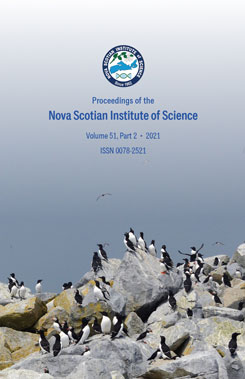Parasitism of Brook Trout (Salvelinus fontinalis) during the first month post-emergence in streams in southwest Nova Scotia
DOI:
https://doi.org/10.15273/pnsis.v51i2.11175Abstract
Parasite recruitment of recently emerged fry of brook trout (Salvelinus fontinalis) in three streams in southwestern Nova Scotia was documented. In early April, fry appeared to leave the protective gravel redds parasite free but began acquiring parasites within the next 2-4 weeks, with prevalence of infections of any given species reaching 21 to 46% by mid-May.
The initial infections involved 1) directly transmitted ectoparasites Gyrodactylus colemanensis and Salmincola edwardsii and 2) food-borne endoparasites (Echinorhynchus lateralis and Crepidostomum sp.). Colonizing parasites found in the first month post-emergence varied by locality: at Bangor Creek, it involved G. colemanensis, E. lateralis, and Crepidostomum sp., while at Germaine East, it involved only G. colemanensis and at Germaine North, only S. edwardsii. In each case, the initial colonizers reflected what was abundant locally and within a regional pool of 10 parasite species. Localized skin thickening and sometimes tissue erosion were evident at sites of attachment of S. edwardsii. Minor disruption of fin margins was seen with G. colemanensis. No pathology was associated with E. lateralis nor Crepidostomum sp. The predictable timing of emergence and ease of sampling fry of S. fontinalis near redds represents a convenient system with which to assess impact of initial parasitism on fish recruitment at the local level.
Keywords: Echinorhynchus, Gyrodactylus, initial parasite colonization, regional parasite pool, Salmincola


